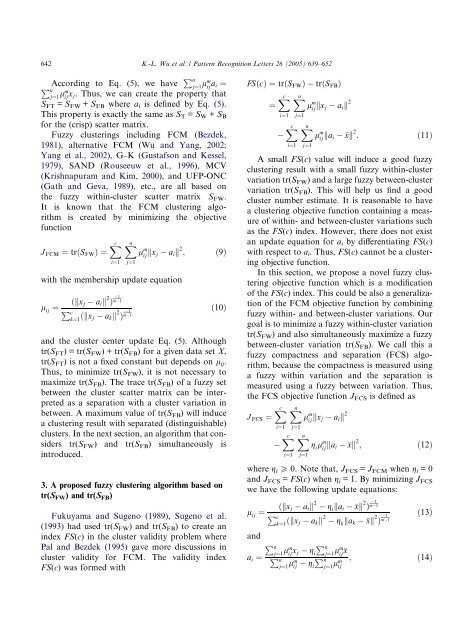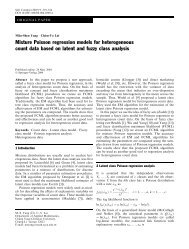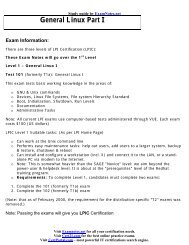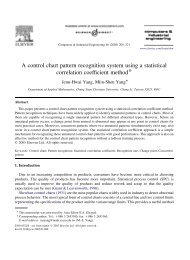A novel fuzzy clustering algorithm based on a fuzzy scatter matrix ...
A novel fuzzy clustering algorithm based on a fuzzy scatter matrix ...
A novel fuzzy clustering algorithm based on a fuzzy scatter matrix ...
Create successful ePaper yourself
Turn your PDF publications into a flip-book with our unique Google optimized e-Paper software.
642 K.-L. Wu et al. / Pattern Recogniti<strong>on</strong> Letters 26 (2005) 639–652<br />
According to Eq. (5), we have P n<br />
j¼1 lm ij a i ¼<br />
P n<br />
j¼1 lm ij x j. Thus, we can create the property that<br />
S FT = S FW + S FB where a i is defined by Eq. (5).<br />
This property is exactly the same as S T = S W + S B<br />
for the (crisp) <strong>scatter</strong> <strong>matrix</strong>.<br />
Fuzzy <str<strong>on</strong>g>clustering</str<strong>on</strong>g>s including FCM(Bezdek,<br />
1981), alternative FCM(Wu and Yang, 2002;<br />
Yang et al., 2002), G–K (Gustafs<strong>on</strong> and Kessel,<br />
1979), SAND (Rouseeuw et al., 1996), MCV<br />
(Krishnapuram and Kim, 2000), and UFP-ONC<br />
(Gath and Geva, 1989), etc., are all <str<strong>on</strong>g>based</str<strong>on</strong>g> <strong>on</strong><br />
the <str<strong>on</strong>g>fuzzy</str<strong>on</strong>g> within-cluster <strong>scatter</strong> <strong>matrix</strong> S FW .<br />
It is known that the FCM<str<strong>on</strong>g>clustering</str<strong>on</strong>g> <str<strong>on</strong>g>algorithm</str<strong>on</strong>g><br />
is created by minimizing the objective<br />
functi<strong>on</strong><br />
J FCM ¼ trðS FW Þ¼ Xc<br />
i¼1<br />
X n<br />
j¼1<br />
with the membership update equati<strong>on</strong><br />
l ij ¼ ðkx j a i k 2 Þ 1<br />
m 1<br />
P c<br />
k¼1 ðkx j a k k 2 Þ 1<br />
m 1<br />
l m ij kx j a i k 2 ; ð9Þ<br />
ð10Þ<br />
and the cluster center update Eq. (5). Although<br />
tr(S FT ) = tr(S FW ) + tr(S FB ) for a given data set X,<br />
tr(S FT ) is not a fixed c<strong>on</strong>stant but depends <strong>on</strong> l ij .<br />
Thus, to minimize tr(S FW ), it is not necessary to<br />
maximize tr(S FB ). The trace tr(S FB ) of a <str<strong>on</strong>g>fuzzy</str<strong>on</strong>g> set<br />
between the cluster <strong>scatter</strong> <strong>matrix</strong> can be interpreted<br />
as a separati<strong>on</strong> with a cluster variati<strong>on</strong> in<br />
between. A maximum value of tr(S FB ) will induce<br />
a <str<strong>on</strong>g>clustering</str<strong>on</strong>g> result with separated (distinguishable)<br />
clusters. In the next secti<strong>on</strong>, an <str<strong>on</strong>g>algorithm</str<strong>on</strong>g> that c<strong>on</strong>siders<br />
tr(S FW ) and tr(S FB ) simultaneously is<br />
introduced.<br />
3. A proposed <str<strong>on</strong>g>fuzzy</str<strong>on</strong>g> <str<strong>on</strong>g>clustering</str<strong>on</strong>g> <str<strong>on</strong>g>algorithm</str<strong>on</strong>g> <str<strong>on</strong>g>based</str<strong>on</strong>g> <strong>on</strong><br />
tr(S FW ) and tr(S FB )<br />
Fukuyama and Sugeno (1989), Sugeno et al.<br />
(1993) had used tr(S FW ) and tr(S FB ) to create an<br />
index FS(c) in the cluster validity problem where<br />
Pal and Bezdek (1995) gave more discussi<strong>on</strong>s in<br />
cluster validity for FCM. The validity index<br />
FS(c) was formed with<br />
FSðcÞ ¼trðS FW Þ<br />
¼ Xc<br />
i¼1<br />
X c<br />
i¼1<br />
X n<br />
j¼1<br />
X n<br />
trðS FB Þ<br />
l m ij kx j a i k 2<br />
j¼1<br />
l m ij ka i xk 2 : ð11Þ<br />
A small FS(c) value will induce a good <str<strong>on</strong>g>fuzzy</str<strong>on</strong>g><br />
<str<strong>on</strong>g>clustering</str<strong>on</strong>g> result with a small <str<strong>on</strong>g>fuzzy</str<strong>on</strong>g> within-cluster<br />
variati<strong>on</strong> tr(S FW ) and a large <str<strong>on</strong>g>fuzzy</str<strong>on</strong>g> between-cluster<br />
variati<strong>on</strong> tr(S FB ). This will help us find a good<br />
cluster number estimate. It is reas<strong>on</strong>able to have<br />
a <str<strong>on</strong>g>clustering</str<strong>on</strong>g> objective functi<strong>on</strong> c<strong>on</strong>taining a measure<br />
of within- and between-cluster variati<strong>on</strong>s such<br />
as the FS(c) index. However, there does not exist<br />
an update equati<strong>on</strong> for a i by differentiating FS(c)<br />
with respect to a i . Thus, FS(c) cannot be a <str<strong>on</strong>g>clustering</str<strong>on</strong>g><br />
objective functi<strong>on</strong>.<br />
In this secti<strong>on</strong>, we propose a <str<strong>on</strong>g>novel</str<strong>on</strong>g> <str<strong>on</strong>g>fuzzy</str<strong>on</strong>g> <str<strong>on</strong>g>clustering</str<strong>on</strong>g><br />
objective functi<strong>on</strong> which is a modificati<strong>on</strong><br />
of the FS(c) index. This could be also a generalizati<strong>on</strong><br />
of the FCMobjective functi<strong>on</strong> by combining<br />
<str<strong>on</strong>g>fuzzy</str<strong>on</strong>g> within- and between-cluster variati<strong>on</strong>s. Our<br />
goal is to minimize a <str<strong>on</strong>g>fuzzy</str<strong>on</strong>g> within-cluster variati<strong>on</strong><br />
tr(S FW ) and also simultaneously maximize a <str<strong>on</strong>g>fuzzy</str<strong>on</strong>g><br />
between-cluster variati<strong>on</strong> tr(S FB ). We call this a<br />
<str<strong>on</strong>g>fuzzy</str<strong>on</strong>g> compactness and separati<strong>on</strong> (FCS) <str<strong>on</strong>g>algorithm</str<strong>on</strong>g>,<br />
because the compactness is measured using<br />
a <str<strong>on</strong>g>fuzzy</str<strong>on</strong>g> within variati<strong>on</strong> and the separati<strong>on</strong> is<br />
measured using a <str<strong>on</strong>g>fuzzy</str<strong>on</strong>g> between variati<strong>on</strong>. Thus,<br />
the FCS objective functi<strong>on</strong> J FCS is defined as<br />
J FCS ¼ Xc X n<br />
l m ij kx j a i k 2<br />
i¼1 j¼1<br />
X c X n<br />
i¼1<br />
j¼1<br />
g i l m ij ka i xk 2 ; ð12Þ<br />
where g i P 0. Note that, J FCS = J FCM when g i =0<br />
and J FCS = FS(c) when g i = 1. By minimizing J FCS<br />
we have the following update equati<strong>on</strong>s:<br />
ðkx j a i k 2 g<br />
l ij ¼<br />
i ka i xk 2 m<br />
Þ 1<br />
1<br />
P c<br />
k¼1 ðkx ð13Þ<br />
j a k k 2 g k ka k xk 2 m<br />
Þ 1<br />
1<br />
and<br />
P n<br />
j¼1<br />
a i ¼<br />
lm ij x j<br />
P n<br />
j¼1 lm ij<br />
P n<br />
g i j¼1 lm ij<br />
P x<br />
g n ; ð14Þ<br />
i j¼1 lm ij







